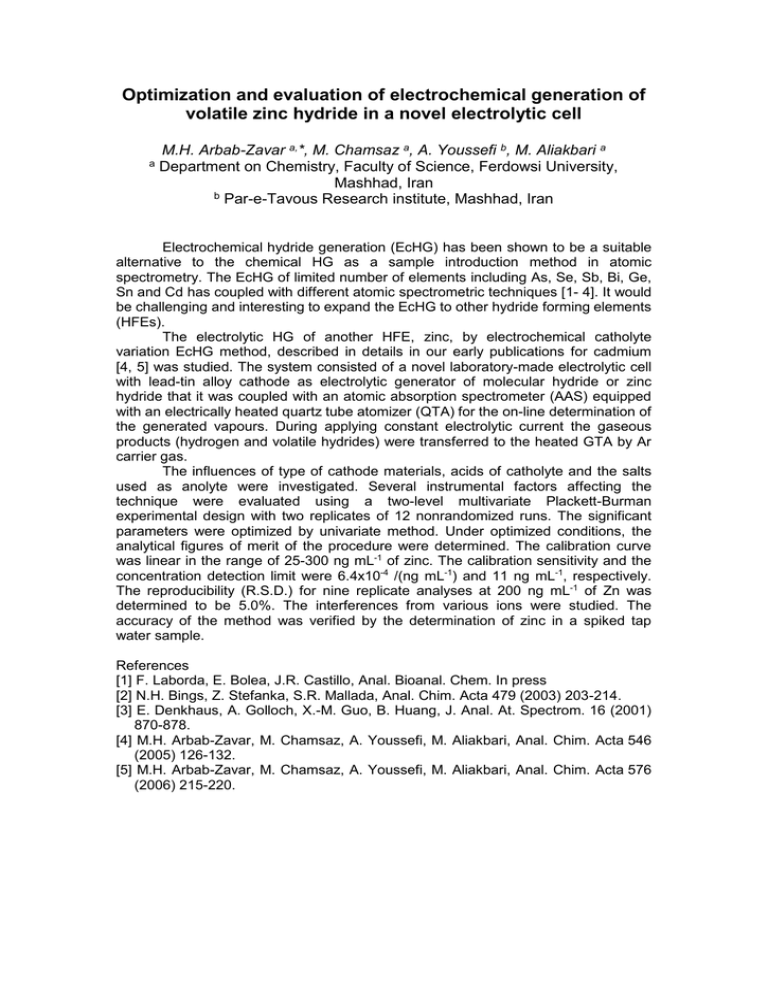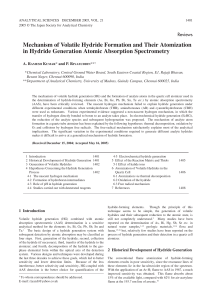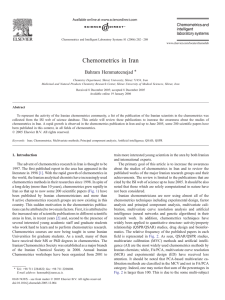Optimization and evaluation of electrochemical generation of
advertisement

Optimization and evaluation of electrochemical generation of volatile zinc hydride in a novel electrolytic cell M.H. Arbab-Zavar a,*, M. Chamsaz a, A. Youssefi b, M. Aliakbari a a Department on Chemistry, Faculty of Science, Ferdowsi University, Mashhad, Iran b Par-e-Tavous Research institute, Mashhad, Iran Electrochemical hydride generation (EcHG) has been shown to be a suitable alternative to the chemical HG as a sample introduction method in atomic spectrometry. The EcHG of limited number of elements including As, Se, Sb, Bi, Ge, Sn and Cd has coupled with different atomic spectrometric techniques [1- 4]. It would be challenging and interesting to expand the EcHG to other hydride forming elements (HFEs). The electrolytic HG of another HFE, zinc, by electrochemical catholyte variation EcHG method, described in details in our early publications for cadmium [4, 5] was studied. The system consisted of a novel laboratory-made electrolytic cell with lead-tin alloy cathode as electrolytic generator of molecular hydride or zinc hydride that it was coupled with an atomic absorption spectrometer (AAS) equipped with an electrically heated quartz tube atomizer (QTA) for the on-line determination of the generated vapours. During applying constant electrolytic current the gaseous products (hydrogen and volatile hydrides) were transferred to the heated GTA by Ar carrier gas. The influences of type of cathode materials, acids of catholyte and the salts used as anolyte were investigated. Several instrumental factors affecting the technique were evaluated using a two-level multivariate Plackett-Burman experimental design with two replicates of 12 nonrandomized runs. The significant parameters were optimized by univariate method. Under optimized conditions, the analytical figures of merit of the procedure were determined. The calibration curve was linear in the range of 25-300 ng mL-1 of zinc. The calibration sensitivity and the concentration detection limit were 6.4x10-4 /(ng mL-1) and 11 ng mL-1, respectively. The reproducibility (R.S.D.) for nine replicate analyses at 200 ng mL-1 of Zn was determined to be 5.0%. The interferences from various ions were studied. The accuracy of the method was verified by the determination of zinc in a spiked tap water sample. References [1] F. Laborda, E. Bolea, J.R. Castillo, Anal. Bioanal. Chem. In press [2] N.H. Bings, Z. Stefanka, S.R. Mallada, Anal. Chim. Acta 479 (2003) 203-214. [3] E. Denkhaus, A. Golloch, X.-M. Guo, B. Huang, J. Anal. At. Spectrom. 16 (2001) 870-878. [4] M.H. Arbab-Zavar, M. Chamsaz, A. Youssefi, M. Aliakbari, Anal. Chim. Acta 546 (2005) 126-132. [5] M.H. Arbab-Zavar, M. Chamsaz, A. Youssefi, M. Aliakbari, Anal. Chim. Acta 576 (2006) 215-220.


